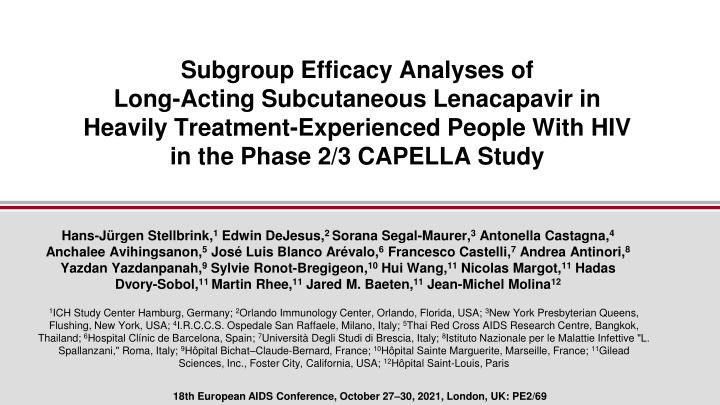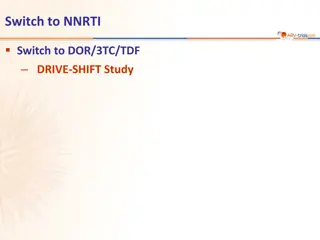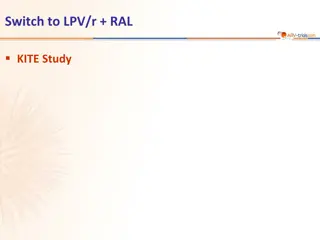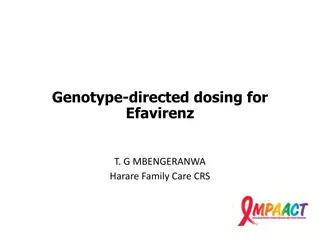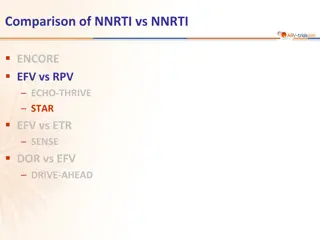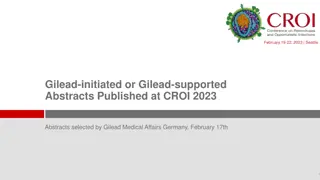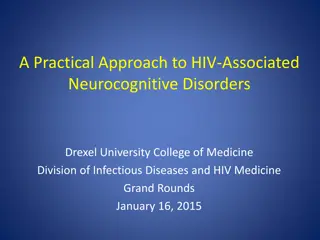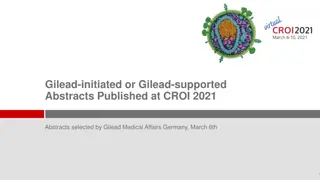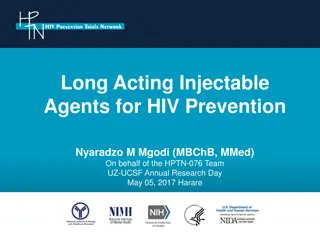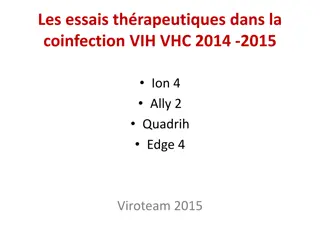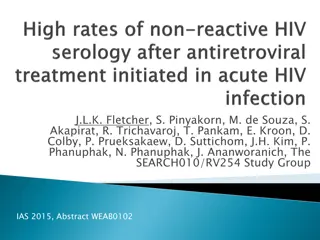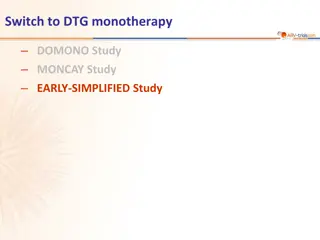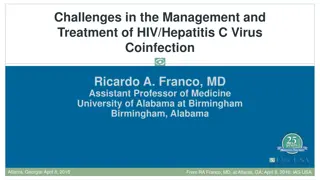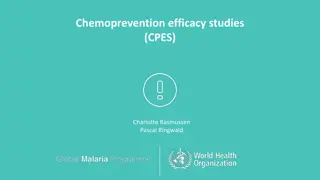Efficacy Analyses of Long-Acting Lenacapavir in HIV Treatment-Experienced Patients
Subgroup efficacy analyses of long-acting subcutaneous lenacapavir in heavily treatment-experienced individuals with HIV in the Phase 2/3 CAPELLA study. Lenacapavir targets multiple stages of the HIV replication cycle, offering a new mechanism of action for multidrug-resistant HIV-1 and reducing daily pill burden through less frequent dosing. This study evaluates the efficacy of lenacapavir based on demographics, baseline HIV-1 RNA levels, CD4 counts, INSTI resistance, and OBR at Week 26.
Download Presentation

Please find below an Image/Link to download the presentation.
The content on the website is provided AS IS for your information and personal use only. It may not be sold, licensed, or shared on other websites without obtaining consent from the author.If you encounter any issues during the download, it is possible that the publisher has removed the file from their server.
You are allowed to download the files provided on this website for personal or commercial use, subject to the condition that they are used lawfully. All files are the property of their respective owners.
The content on the website is provided AS IS for your information and personal use only. It may not be sold, licensed, or shared on other websites without obtaining consent from the author.
E N D
Presentation Transcript
Subgroup Efficacy Analyses of Long-Acting Subcutaneous Lenacapavir in Heavily Treatment-Experienced People With HIV in the Phase 2/3 CAPELLA Study Hans-J rgen Stellbrink,1Edwin DeJesus,2 Sorana Segal-Maurer,3Antonella Castagna,4 Anchalee Avihingsanon,5Jos Luis Blanco Ar valo,6Francesco Castelli,7Andrea Antinori,8 Yazdan Yazdanpanah,9Sylvie Ronot-Bregigeon,10Hui Wang,11Nicolas Margot,11Hadas Dvory-Sobol,11 Martin Rhee,11Jared M. Baeten,11Jean-Michel Molina12 1ICH Study Center Hamburg, Germany; 2Orlando Immunology Center, Orlando, Florida, USA; 3New York Presbyterian Queens, Flushing, New York, USA; 4I.R.C.C.S. Ospedale San Raffaele, Milano, Italy; 5Thai Red Cross AIDS Research Centre, Bangkok, Thailand; 6Hospital Cl nic de Barcelona, Spain; 7Universit Degli Studi di Brescia, Italy; 8Istituto Nazionale per le Malattie Infettive "L. Spallanzani," Roma, Italy; 9H pital Bichat Claude-Bernard, France; 10H pital Sainte Marguerite, Marseille, France; 11Gilead Sciences, Inc., Foster City, California, USA; 12H pital Saint-Louis, Paris 18th European AIDS Conference, October 27 30, 2021, London, UK: PE2/69
Introduction: Lenacapavir (LEN, GS-6207) Targets Multiple Stages of HIV Replication Cycle1,2 EC50, half-maximal effective concentration; Gag, group antigens; Pol, polyprotein. 2
Introduction LEN is a novel, highly potent, long-acting, first-in-class, HIV-1 capsid inhibitor LEN can meet significant unmet medical needs: A new mechanism of action for multidrug-resistant HIV-1 Reduction of daily pill burden through less frequent dosing for treatment and prevention Highly desirable in vitro profile with picomolar antiviral activity (EC50: 50 100 pM) Retains full activity against nucleoside reverse-transcriptase inhibitor (NRTI) , non-NRTI , integrase strand transfer inhibitor (INSTI) , and protease inhibitor (PI) resistant mutants3-5 No observed preexisting resistance3,6 Subcutaneous (SC) LEN can be administered q6mo7 LEN demonstrated potent antiviral activity in people with HIV (PWH), with up to 2.3 log decline8 In treatment-na ve PWH, LEN + emtricitabine/tenofovir alafenamide led to 94% virologic suppression at Week 289 In heavily treatment-experienced (HTE) people with multidrug resistant HIV-1: LEN achieved its primary endpoint as a functional monotherapy when added to a failing regimen10: Participants with 0.5-log decline: LEN 88% vs placebo 17% (p<0.001) HIV-1 RNA decline, mean: LEN 1.9 vs 0.3 log (p<0.001) LEN + optimized background regimen (OBR) led to 81% virologic suppression at Week 2611 3
Objective To evaluate Week 26 efficacy (assessed using U.S. Food & Drug Administration [FDA] Snapshot algorithm) by subgroup analyses in a randomized cohort by demographics and baseline HIV-1 RNA, cluster of differentiation-4 (CD4), INSTI resistance, and OBR 4
Methods: Study Design Key eligibility criteria: HIV-1 RNA 400 c/mL Resistance to 2 agents from 3 of 4 main ARV classes 2 fully active agents from 4 main ARV classes Maintenance Functional monotherapy (14 d) Oral LEN* SC LEN q6mo for 52 wk* n=24 Failing regimen OBR Randomized cohort (double blind) NO Placebo Oral LEN* SC LEN q6mo for 52 wk* n=12 Screening Period Failing regimen OBR Prerandomization repeat HIV-1 RNA Decline 0.5 log c/mL (vs screening); or <400 c/mL YES Oral LEN* SC LEN q6mo for 52 wk* n=36 Nonrandomized cohort (open label) OBR OBR Efficacy was summarized only for the randomized cohort (n=36), as most in the nonrandomized cohort have not reached Week 26 yet Safety was summarized for both the randomized and nonrandomized cohorts (N=72) *Administered as 600 mg on Days 1 and 2, and 300 mg on Day 8; SC LEN administered as 927 mg (2 x 1.5 mL) in abdomen on Day 15; Investigational agents, such as fostemsavir, were allowed; atazanavir (ATV), ATV/cobicistat, ATV/ritonavir, efavirenz, entecavir, ipranavir, and nevirapine were not allowed. ARV, antiretroviral. 5
Results: Baseline Characteristics Randomized LEN n=24 55 (24 71) 29 42 25 4.2 (2.3 5.4) 17 172 (16 827) 67 9 (2 24) 3 (1 7) 4 (2 6) Nonrandomized LEN n=36 49 (23 78) 22 31 14 4.5 (1.3 5.7) 28 195 (3 1296) 53 13 (3 25) 4 (2 7) 4 (2 6) Placebo n=12 54 (27 59) 25 55 36 4.9 (4.3 5.3) 50 85 (6 237) 92 9 (3 22) 3 (2 6) 4 (2 7) Total N=72 52 (23 78) 25 38 21 4.5 (1.3 5.7) 28 150 (3 1296) 64 11 (2 25) 3 (1 7) 4 (2 7) Age, median (range), years Sex, % female at birth Race, % Black Ethnicity, % Hispanic/Latinx HIV-1 RNA, median (range), log10c/mL >75,000 c/mL, % CD4 count, median (range), cells/ L 200 cells/ L, % No. of prior ARV agents, median (range) No. of ARV agents in failing regimen, median (range) No. of ARV agents in OBR, median (range) No. of fully active agents in OBR, % 0 1 2 Known resistance to 2 drugs in class, % NRTI NNRTI PI INSTI 17 29 54 17 58 25 17 36 47 17 38 46 96 92 83 83 100 100 67 58 100 100 83 64 99 97 81 69 6
Composition of Failing Regimen and OBR Class/Agent, % Failing Regimen: N=72 OBR: N=72 NRTI 82 85 INSTI 68 65 PI 63 63 NNRTI 31 33 Ibalizumab (CD4-directed postattachment inhibitor) 19 24 Maraviroc (CCR5 entry inhibitor) 14 14 Fostemsavir (attachment inhibitor) 6 11 Enfuvirtide (fusion inhibitor) 6 7 No. of fully active ARV agents, % 0 1 2 OSS, median* 42 36 22 1.0 17 38 46 2.0 *Overall susceptibility scores (OSS; 1, 0.5, or 0 for full, partial, or no susceptibility, respectively) were determined based on proprietary algorithm (Monogram Biosciences Inc., South San Francisco, California, USA); for historical resistance reports, scores were derived from data provided by investigators; OSS of OBR was sum of individual scores. CCR5, C-C chemokine receptor type-5. 17 of 72 participants (24%) had no changes in their OBR 7
Efficacy at Week 26 in Randomized Cohort (n=36) FDA-Snapshot Algorithm11 100 89 81 80 Participants, % 60 40 19 20 11 0 0 0 <50 <200 No Virologic Data 50 200 HIV-1 RNA, c/mL 29 HIV-1 RNA, c/mL n= 32 7 4 0 0 8
Efficacy by Demographics* 100 100 90 HIV-1 RNA <50 c/mL, % (95% CI) 84 83 81 81 77 80 74 71 Participants With 60 40 20 0 Overall <50 Male Female Black Non-Black USA Ex-USA 50 Age, years Sex at Birth Race Region n= 36 9 27 26 10 16 19 29 7 *Prespecified subgroup analyses; Total n in each subgroup; 1 participant with race reported as not permitted. CI, confidence interval. 9
Efficacy by Baseline CD4 and HIV-1 RNA* 100 89 86 HIV-1 RNA <50 c/mL, % (95% CI) 81 78 80 Participants With 57 60 40 20 0 Overall <200 >100,000 200 100,000 CD4, cells/ L HIV-1 RNA, c/mL n= 36 27 9 29 7 *Prespecified subgroup analyses; Total n in each subgroup. 10
Efficacy by No. of Fully Active Agents in OBR* 100 86 HIV-1 RNA <50 c/mL, % (95% CI) 81 81 80 67 Participants With 60 40 20 0 Overall 0 1 2 No. of Fully Active Agents in OBR n= 36 6 14 16 *Post hoc subgroup analyses; Total n in each subgroup. 11
Efficacy by Baseline OBR Sensitivity Score* 100 92 HIV-1 RNA <50 c/mL, % (95% CI) 81 78 80 67 Participants With 60 40 20 0 Overall 0 <1 1 <2 2 OSS n= 36 6 12 18 *Prespecified subgroup analyses; Total n in each subgroup. 12
Efficacy by Baseline INSTI Resistance* 100 HIV-1 RNA <50 c/mL, % (95% CI) 85 81 80 Participants With 63 60 40 20 0 Overall Yes No INSTI Resistance n= 36 27 8 *Prespecified subgroup analyses; Total n in each subgroup; Included phenotypic and genotypic resistance to bictegravir, cabotegravir, dolutegravir (DTG), elvitegravir, and raltegravir; 1 participant had missing baseline INSTI resistance data. 13
Efficacy by Baseline Use of Dolutegravir and/or Darunavir* 100 HIV-1 RNA <50 c/mL, % (95% CI) 83 81 81 81 80 78 78 80 Participants With 60 40 20 0 Overall Yes No Yes No Yes No DTG DRV DTG or DRV n= 36 18 18 21 15 27 9 *Post hoc subgroup analyses; Total n in each subgroup. DRV, darunavir. 14
Efficacy by Baseline Use of Dolutegravir and/or Darunavir* 100 HIV-1 RNA <50 c/mL, % (95% CI) 83 83 81 78 78 80 Participants With 60 40 20 0 Overall DTG and DRV DTG, no DRV DRV, no DTG No DTG or DRV n= 36 12 6 9 9 *Post hoc subgroup analyses; Total n in each subgroup. 15
Efficacy by Baseline Use of Ibalizumab* 100 HIV-1 RNA <50 c/mL, % (95% CI) 83 81 80 75 Participants With 60 40 20 0 Overall Yes No IMAB n= 36 12 24 *Post hoc subgroup analyses; 3 participants were on fostemsavir and all had HIV-1 RNA <50 c/mL at Week 26; Total n in each subgroup. 16
Conclusions In HTE PWH with limited treatment options due to multidrug resistance, LEN demonstrated a clinically meaningful contribution towards virologic suppression in combination with an OBR No clinically relevant differences were seen in efficacy among subgroups who were considered more difficult to treat (eg, those with low CD4 count, INSTI resistance, no fully active agents, or no DTG or DRV in the OBR) LEN has the potential to become an important agent for HTE PWH with multidrug resistance These data support the ongoing evaluation of LEN for treatment and prevention of HIV 17
References 1. Bester SM, et al. Science 2020;370:360-4; 2. Link JO, et al. Nature 2020;584:614-8; 3. Margot N, et al. CROI 2020, poster 529; 4. VanderVeen L, et al. CROI 2021, oral 01781; 5. Yant SR, et al. CROI 2019, poster 480; 6. VanderVeen L, et al. IDWeek 2021, oral 73; 7. Begley R, et al. AIDS 2020, poster PEB0265; 8. Daar E, et al. CROI 2020, poster 3691; 9. Gupta SK, et al. IAS 2021, oral OALB0302; 10. Segal-Maurer S, et al. CROI 2021, oral 2228. 11. Molina JM, et al. IAS 2021, oral OALX01LB02. 18
Acknowledgments We extend our thanks to: The study participants and their families Participating study investigators and staff: Canada: J Brunetta, B Trottier; Dominican Republic: E Koenig; France: J-M Molina, S Ronot-Bregigeon, Y Yazdanpanah; Germany: H-J Stellbrink; Italy: A Antinori, A Castagna, F Castelli; Japan: T Shirasaka, Y Yokomaku; South Africa: M Rassool; Spain: J Mallolas; Taiwan: C-C Hung; Thailand: A Avihingsanon, P Chetchotisakd, W Ratanasuwan, K Siripassorn; United States: DS Berger, M Berhe, C Brinson, CM Creticos, GE Crofoot, E DeJesus, D Hagins, T Hodge, K Lichtenstein, JP McGowan, O Ogbuagu, O Osiyemi, GJ Richmond, MN Ramgopal, PJ Ruane, W Sanchez, S Segal-Maurer, J Sims, GI Sinclair, DA Wheeler, A Wiznia, K Workowski, C Zurawski This study was funded by Gilead Sciences, Inc. 19
